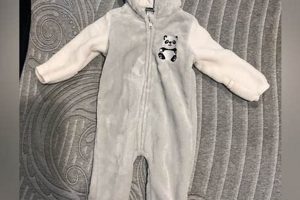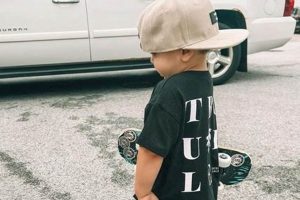Garments and attire for infants and toddlers that reflect the styles and designs prevalent in past decades, typically ranging from the mid-20th century to more recent decades, constitute a distinct category of childrenswear. These items often feature specific color palettes, patterns, and fabrics characteristic of their respective eras. For example, a romper with pastel hues and geometric shapes may evoke the 1960s, while corduroy overalls suggest the 1970s.
The appeal of vintage-inspired infant apparel stems from several factors. It offers a connection to nostalgia, allowing parents to express personal style preferences or childhood memories. Furthermore, some individuals value the craftsmanship and unique designs often associated with older manufacturing techniques. Historically, such apparel provides insights into societal trends and evolving perceptions of childhood throughout different periods.
Understanding the enduring popularity of these vintage-inspired items necessitates exploring several key aspects. This analysis includes examining the specific eras that influence current trends, identifying common materials and design features, and considering the practical considerations involved in selecting and caring for such garments.
Guidance on Acquiring and Maintaining Vintage-Inspired Infant Apparel
The following recommendations are provided to ensure informed decisions when selecting and caring for garments that evoke past eras for infants.
Tip 1: Assess Fabric Integrity: Prior to purchase, carefully inspect the fabric for signs of degradation, such as discoloration, thinning, or tearing. Delicate materials may require professional restoration.
Tip 2: Verify Authenticity: Distinguish genuine vintage items from modern reproductions. Research trademarks, labels, and construction methods to confirm the age and origin of the garment.
Tip 3: Prioritize Safety: Ensure any decorative elements, such as buttons, snaps, or ribbons, are securely attached to prevent choking hazards. Avoid items with loose or damaged components.
Tip 4: Consider Sizing Variations: Note that sizing standards have evolved over time. Consult size charts specific to the era the garment originates from, or opt for larger sizes to accommodate growth.
Tip 5: Implement Gentle Cleaning Methods: Hand-washing with a mild detergent is recommended for delicate fabrics. Avoid harsh chemicals or abrasive cleaning agents that could damage the garment.
Tip 6: Safe Storage Practices: Store vintage-inspired infant apparel in a cool, dry, and dark place to prevent fading or deterioration. Acid-free tissue paper can be used to protect delicate fabrics.
Tip 7: Modification Considerations: Modern alterations might compromise the value and originality of the garment. If modifications are necessary, seek a skilled tailor specializing in vintage restoration.
Adhering to these recommendations ensures the longevity and safety of garments designed to evoke past decades for infants, preserving both their aesthetic appeal and historical significance.
Applying these guidelines to acquisition and care facilitates a deeper appreciation for the nuances of vintage-inspired infant apparel. The subsequent sections will explore specific historical influences, design elements, and contemporary interpretations.
1. Nostalgic aesthetic
The nostalgic aesthetic, in the context of infant apparel designed with past eras in mind, constitutes a powerful driving force behind its popularity. This phenomenon arises from a yearning for perceived simplicity and innocence associated with bygone decades. Parents, and gift-givers, often gravitate towards designs reminiscent of their own childhoods or idealized versions of past eras, leading to a consumer preference for apparel that evokes specific time periods. For example, a baby romper replicating a 1950s poodle skirt design leverages the established cultural recognition of that era’s aesthetic.
The practical significance of understanding this connection lies in its influence on market trends and design choices. Manufacturers and designers capitalize on this nostalgia by incorporating specific colors, patterns, and silhouettes characteristic of identified eras. Marketing campaigns often emphasize the sentimental value and emotional connection associated with these styles. For instance, advertisements might showcase sepia-toned images of vintage toys alongside the apparel, reinforcing the intended emotional response. This strategic approach maximizes product appeal to specific demographic groups.
While the incorporation of nostalgia is prevalent, challenges arise in balancing historical accuracy with contemporary practicality and safety standards. Modern infants cannot wear apparel constructed with historically accurate materials if those materials pose a safety risk. The successful implementation of this aesthetic involves modernizing vintage designs while retaining their original charm, requiring careful consideration of fabric choices, construction methods, and adherence to contemporary safety regulations. Understanding this balance is critical for creating appealing and safe infant clothing.
2. Vintage-inspired Fabrics
The resurgence of retro baby clothes is inextricably linked to the utilization of vintage-inspired fabrics. These materials, while often distinct from authentic vintage textiles due to safety or availability concerns, play a crucial role in recreating the aesthetic of past decades. The visual and tactile qualities of these fabrics are central to the overall impression of retro baby clothes; without them, the garments would lack the intended historical character. The deliberate choice of specific prints, weaves, and textures directly contributes to the item’s ability to evoke a particular era. For example, the use of gingham or seersucker immediately suggests mid-20th century aesthetics, while pastel-colored corduroy is closely associated with the 1970s. This conscious selection of materials is not merely decorative; it’s foundational to the design’s intent.
Contemporary manufacturers utilize various strategies to replicate the qualities of vintage fabrics while addressing modern needs. Digital printing techniques allow for the reproduction of intricate vintage patterns on safer and more durable materials, such as organic cotton. Similarly, modern blends of fibers can mimic the drape and texture of older fabrics while offering improved washability and resistance to wear. This adaptation demonstrates a practical understanding of the constraints and demands of the modern market. However, the success of this approach hinges on maintaining the integrity of the original design elements. Subtle variations in color or texture can significantly alter the overall effect, diminishing the garment’s retro appeal. The selection process requires careful attention to detail to ensure a faithful representation of the intended era.
In conclusion, the relationship between vintage-inspired fabrics and retro baby clothes is one of mutual dependence. The fabrics provide the tangible link to the past, while the designs utilize these materials to create a specific historical aesthetic. While challenges exist in replicating the exact qualities of vintage materials, contemporary techniques offer viable solutions. Ultimately, the success of retro baby clothes depends on the careful and informed selection of fabrics that effectively capture the essence of the desired era, balanced with a commitment to modern safety and practicality standards. Understanding this relationship is critical for manufacturers, designers, and consumers alike.
3. Safety Standards Adaptation
The design and manufacture of infant apparel styled to evoke previous eras require meticulous adherence to contemporary safety standards. Historically accurate designs often present inherent risks that necessitate modification for modern use. This adaptation is paramount to ensure the well-being of infants and compliance with legal regulations. Ignoring current safety standards in the pursuit of historical authenticity is untenable.
- Flammability Regulations
Fabrics commonly used in past decades may not meet current flammability standards. Modern interpretations often substitute these materials with inherently flame-resistant textiles or apply flame-retardant treatments to ensure compliance. This substitution alters the material composition but maintains the visual appearance while mitigating fire hazards.
- Small Parts and Entrapment Hazards
Vintage-inspired designs may feature buttons, ribbons, or other small embellishments that pose choking hazards if detached. Garments must undergo rigorous testing to ensure these components are securely affixed and incapable of being easily removed. Similarly, necklines and openings must adhere to specific dimensions to prevent entrapment risks.
- Lead Content and Harmful Substances
Paints and dyes used in historical manufacturing processes may contain lead or other harmful substances now prohibited in infant products. Modern production methods necessitate the use of lead-free alternatives and rigorous testing to verify the absence of harmful chemicals in the finished product. This safeguards against potential health risks associated with skin contact or ingestion.
- Seam Strength and Durability
The construction techniques employed in older garments may not withstand the rigors of modern laundering or the active movements of infants. Reinforced seams and durable stitching methods are implemented to ensure the garment’s structural integrity and prevent tears or separations that could create hazardous conditions.
The successful integration of contemporary safety measures into the design of vintage-inspired infant apparel demands a delicate balance between historical accuracy and practical considerations. While aesthetic fidelity is important, the safety and well-being of the child must take precedence. Manufacturers must prioritize compliance with relevant safety regulations and conduct thorough testing to ensure that garments meet or exceed established standards. Failure to do so carries significant legal and ethical ramifications.
4. Collectibility, Value
The intersection of collectibility and perceived value significantly influences the market for garments evoking past eras designed for infants. This dynamic arises from a confluence of factors, including rarity, historical provenance, design aesthetics, and condition. Certain items, particularly those from well-known designers or limited production runs, acquire elevated status within collecting circles. Consequently, prices for these pieces often exceed those of comparable modern garments, reflecting their desirability among collectors and enthusiasts. A demonstrable historical connection, such as verifiable use by a notable individual or association with a significant cultural event, further amplifies an item’s collectibility and subsequent market value. The condition of the item, particularly for truly vintage examples, critically affects its valuation; pristine condition commands a premium, while damage or alterations detract from potential worth. This dynamic differs significantly from the broader market, where function and safety are paramount; collectors frequently prioritize historical accuracy and rarity over practical wearability.
The practical implication of this dynamic extends beyond individual collectors. The awareness of potential collectibility influences purchasing decisions even among consumers not actively engaged in collecting. The perception of long-term value, whether based on tangible investment potential or simply a belief in the garment’s enduring appeal, can justify higher initial expenditure. This phenomenon encourages manufacturers to produce higher-quality reproductions of vintage styles, incorporating superior materials and construction techniques to enhance their desirability. Furthermore, the existence of a secondary market for these garments fosters a sense of community and shared appreciation, promoting both the preservation of historical designs and the ongoing evolution of the market. Examples include authenticated pieces from mid-century designers that command high prices at vintage auctions, and modern reproductions that utilize high-quality materials to appeal to consumers seeking a balance between vintage style and contemporary durability.
In summary, the interplay between collectibility and value serves as a significant driver within the market for garments designed with infants and toddlers in mind, evoking past decades. While the practical considerations of safety and functionality remain essential, the presence of a collecting community and the perception of enduring value introduce a unique dimension to purchasing decisions. This dynamic underscores the importance of understanding historical context, design aesthetics, and market trends when assessing the worth of such items, and appreciating the influence of collectors in preserving and promoting these garments. The challenge lies in balancing the desire for historical accuracy with the imperative of ensuring safety and practicality for modern use.
5. Ethical production
The resurgence of garments that evoke past eras designed for infants intersects with a growing consumer demand for ethical production practices. This demand extends beyond mere aesthetics; purchasing decisions increasingly reflect concerns regarding labor conditions, environmental impact, and supply chain transparency. Consequently, the manufacturers that specialize in this niche market face mounting pressure to demonstrate a commitment to responsible sourcing and manufacturing. Unethical practices, such as the exploitation of garment workers or the use of environmentally damaging dyes, can severely damage brand reputation and erode consumer trust. Therefore, ethical production is not merely an optional consideration, but a critical component of long-term sustainability for brands that produce apparel reminiscent of previous decades for infants.
The practical application of ethical production principles manifests in several key areas. Fair wages and safe working conditions for garment workers are paramount. This necessitates independent audits of factories to ensure compliance with labor laws and international standards. The use of sustainable and environmentally friendly materials, such as organic cotton or recycled fabrics, minimizes the environmental footprint of production. Transparent supply chains, allowing consumers to trace the origin of materials and the manufacturing process, build trust and accountability. Furthermore, certifications from recognized organizations, such as Fair Trade or GOTS (Global Organic Textile Standard), provide independent verification of ethical practices. For example, brands that collaborate with artisan communities, paying fair prices for handcrafted details, demonstrate a commitment to supporting local economies and preserving traditional skills. These initiatives not only contribute to a more equitable and sustainable industry but also enhance brand value and consumer loyalty.
In conclusion, the connection between ethical production and the market for vintage-inspired apparel for infants is increasingly significant. While the aesthetic appeal of retro designs remains a driving factor, consumers are more discerning, demanding assurance that their purchases align with their values. Ethical production is no longer a niche concern but a fundamental expectation. Brands that prioritize transparency, fair labor practices, and environmental responsibility are better positioned to thrive in this evolving market. However, challenges remain in verifying ethical claims and ensuring consistent standards across complex global supply chains. Overcoming these challenges requires ongoing collaboration between manufacturers, consumers, and independent certification bodies to foster a more ethical and sustainable apparel industry.
Frequently Asked Questions Regarding Retro Baby Clothes
The following questions and answers address common inquiries and concerns regarding garments and attire for infants and toddlers that reflect the styles and designs prevalent in past decades.
Question 1: What defines apparel as “retro” in the context of infant garments?
Retro infant garments are defined by stylistic elements, such as patterns, colors, and silhouettes, characteristic of specific decades in the past, generally ranging from the mid-20th century to recent decades. The term denotes an intentional imitation or evocation of historical fashion trends rather than inherent age.
Question 2: Are vintage-inspired infant garments safe for modern use, given that safety standards have evolved?
Contemporary garments drawing inspiration from past eras must adhere to prevailing safety regulations. Reputable manufacturers incorporate features such as secure closures, lead-free dyes, and flame-resistant materials to ensure the safety of the infant, even if those features were not present in the original designs.
Question 3: How does one distinguish between authentic vintage garments and modern reproductions of older styles?
Differentiating between genuine vintage items and reproductions requires close examination. Authentic garments often exhibit signs of wear, utilize specific historical manufacturing techniques, and bear labels or trademarks indicative of their era. Reproductions, while often visually similar, typically employ modern materials and construction methods.
Question 4: What are the recommended cleaning and care procedures for these delicate garments?
Gentle cleaning methods are generally advised. Hand-washing with mild detergents is preferable for delicate fabrics. Avoid harsh chemicals, bleach, or high-temperature drying, which may damage or degrade the materials. Always consult the care label for specific instructions.
Question 5: How does the collectibility of specific designs influence the market value of this apparel?
Rarity, historical significance, and condition contribute to the collectibility of certain designs. Garments associated with renowned designers, limited production runs, or notable historical events often command higher prices due to their increased desirability among collectors.
Question 6: What ethical considerations are pertinent when purchasing such attire?
Ethical considerations include labor practices, environmental impact, and supply chain transparency. Consumers may seek garments produced under fair labor conditions, utilizing sustainable materials, and adhering to responsible manufacturing processes.
In summary, careful consideration of safety, authenticity, care requirements, and ethical production practices is essential when selecting garments reminiscent of previous decades for infants.
The subsequent section will delve into the specific historical influences and design elements that continue to shape the market for retro baby clothes.
Conclusion
The preceding analysis has explored various facets of garments reminiscent of past decades designed for infants, encompassing historical influences, design elements, safety standards, collectibility, and ethical production. These considerations underscore the complexity of a market segment that balances nostalgic appeal with contemporary requirements. The enduring popularity of these items reflects a broader cultural interest in evoking specific historical periods, while also navigating the practical constraints of modern infant care.
The continued success of this niche relies on a conscientious approach to design, manufacturing, and marketing. Stakeholders must prioritize safety, authenticity, and ethical practices to ensure both the well-being of infants and the long-term sustainability of the industry. Continued diligence in these areas will determine the future viability and cultural relevance of designs reminiscent of previous decades intended for infants.




![Shop Perfect Size 70 Baby Clothes | [Brand Name] Baby Care 101: Essential Tips for Happy, Healthy Babies Shop Perfect Size 70 Baby Clothes | [Brand Name] | Baby Care 101: Essential Tips for Happy, Healthy Babies](https://singlebabies.com/wp-content/uploads/2025/11/th-424-300x200.jpg)


